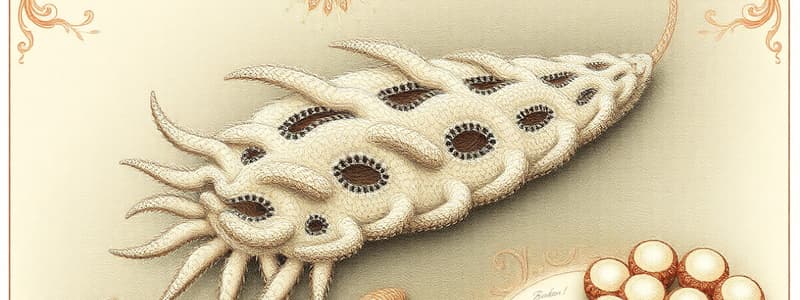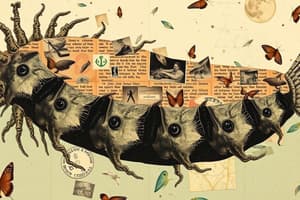Podcast
Questions and Answers
Which characteristic is unique to echinoderms and aids in their locomotion, feeding, and respiration?
Which characteristic is unique to echinoderms and aids in their locomotion, feeding, and respiration?
- A water-vascular system (correct)
- A complex nervous system
- An exoskeleton of chitin
- A closed circulatory system
Echinoderms are named for their scaled skin.
Echinoderms are named for their scaled skin.
False (B)
What is the term for the defense mechanism used by sea cucumbers where they expel their internal organs?
What is the term for the defense mechanism used by sea cucumbers where they expel their internal organs?
Evisceration
Sea urchins use a specialized mouth structure called _______ to graze on algae and other food sources.
Sea urchins use a specialized mouth structure called _______ to graze on algae and other food sources.
Match the following echinoderms with their unique features:
Match the following echinoderms with their unique features:
What is the primary role of sea cucumbers in their marine environment?
What is the primary role of sea cucumbers in their marine environment?
Starfish use their tube feet for movement and sensing only.
Starfish use their tube feet for movement and sensing only.
What is the term for the hard skeleton of a dead sea urchin after it loses its spines?
What is the term for the hard skeleton of a dead sea urchin after it loses its spines?
Starfish feed by expelling their _______ through their mouth to digest prey externally.
Starfish feed by expelling their _______ through their mouth to digest prey externally.
Match the defense mechanisms with the echinoderm that uses it.
Match the defense mechanisms with the echinoderm that uses it.
Which of the following is a common method of asexual reproduction in both sea stars and sea cucumbers?
Which of the following is a common method of asexual reproduction in both sea stars and sea cucumbers?
All species of sea urchins use their spines primarily for capturing prey.
All species of sea urchins use their spines primarily for capturing prey.
What sensory organs do starfish possess at the end of their arms?
What sensory organs do starfish possess at the end of their arms?
The mouth of the sea urchin contains a complex structure known as _______, which is used for grazing on algae.
The mouth of the sea urchin contains a complex structure known as _______, which is used for grazing on algae.
Match the habitat with the echinoderm.
Match the habitat with the echinoderm.
Which of these is a key difference between sexual reproduction in starfish and sea urchins?
Which of these is a key difference between sexual reproduction in starfish and sea urchins?
Sea cucumbers are exclusively carnivorous.
Sea cucumbers are exclusively carnivorous.
Besides locomotion, what other key functions do tube feet serve in sea urchins?
Besides locomotion, what other key functions do tube feet serve in sea urchins?
Before ingesting it, a starfish will often ______ its stomach to digest prey externally.
Before ingesting it, a starfish will often ______ its stomach to digest prey externally.
Match each echinoderm with its predators.
Match each echinoderm with its predators.
Flashcards
Echinoderms
Echinoderms
Marine animals with spiny skin, including sea stars, sea urchins, and sea cucumbers.
Endoskeleton (Echinoderms)
Endoskeleton (Echinoderms)
Internal skeleton located beneath the skin in echinoderms.
Water-vascular System
Water-vascular System
A system of water-filled canals used for locomotion, food and waste transportation, and breathing in echinoderms.
Sea Cucumbers (Holothuroidea)
Sea Cucumbers (Holothuroidea)
Signup and view all the flashcards
Evisceration (Sea Cucumbers)
Evisceration (Sea Cucumbers)
Signup and view all the flashcards
Sea Stars (Asteroidea)
Sea Stars (Asteroidea)
Signup and view all the flashcards
Sea Star Feeding Method
Sea Star Feeding Method
Signup and view all the flashcards
Sea Urchins (Echinoidea)
Sea Urchins (Echinoidea)
Signup and view all the flashcards
Aristotle's Lantern
Aristotle's Lantern
Signup and view all the flashcards
Sea Urchin Spines
Sea Urchin Spines
Signup and view all the flashcards
Study Notes
- Echinoderms include sea cucumbers, sea stars, sea urchins, brittle stars, and sand dollars.
- "Echinoderm" means "spiny skin" in Greek.
- Most echinoderms are either sessile or slow-moving.
- Echinoderms possess an endoskeleton beneath the skin.
- They have a water-vascular system instead of a heart or blood system.
- The water-vascular system uses water-filled canals for locomotion, food and waste transportation, and breathing.
Sea Cucumbers (Hollothuroidea)
- Worm-like creatures with 5 rows of tube feet.
- Lifespan: 5-10 years.
- Can grow up to 6.5 feet.
- Vary in color.
- Breathe through their anus.
- Found in all oceans at all depths (benthic).
- Common in tropical/warm waters.
- Ingest organic matter from soil sediment.
- Scavenge for algae, small organisms, and waste.
- Use tentacles to pass food into their mouths.
- Capable of both sexual reproduction through spawning and asexual reproduction through fission/budding.
- Considered delicacies in some cultures.
- Use evisceration (expelling guts) as a defense mechanism.
- Important for soil and sediment filtering and cycling.
Sea Stars (Asteroidea)
- Can live up to 35 years and weigh up to 11 lbs.
- Most have 5 arms but can have up to 50.
- Senses: touch, light, temperature, orientation.
- Tube feet facilitate movement and suction.
- Found in all oceans at all depths.
- Common in kelp forests, tide pools, rocky beds, coral shores, seagrass, and reefs.
- Opportunistic feeders and carnivorous.
- Diet includes clams, oysters, and snails.
- Digest prey externally by expelling their stomach through their mouth and using enzymes.
- Often gather in large groups to feed.
- Can reproduce sexually via spawning or asexually via regeneration/fission.
- Examples include crown of thorns, chocolate chip seastar, sunflower star, and doughboy star.
- Can regenerate lost arms.
- Have eye spots at the end of their arms.
- Use arms to communicate and wrestle when competing for territory.
- Predators include sea anemones, starfish, snails, crabs, and fish.
- Defense mechanisms: sharp spines, bitter-tasting toxic chemicals, secreting toxic slime, and shedding arms.
Sea Urchins (Echinoidea)
- Spherical bodies with extendable spines.
- Spines are used for protection, movement, and sensing.
- Tube feet are used for movement, grasping food, and breathing.
- Can live up to 100 or even 200 years.
- The skeleton is called a "test" and loses spines when dead.
- Found in all oceans at all depths (benthic).
- Generally found on rocky substrates.
- Can drill holes in rock for shelter.
- Scavengers and omnivores, feeding on detritus and algae.
- Possess a mouth called "Aristotle's Lantern" with 5 teeth-like structures.
- Reproduce by spawning.
- Some species carry eggs between their spines.
- Predators include sea otters, wolf eels, and triggerfish.
- Spines can regenerate if broken and may contain poison.
- Capable of causing injuries to divers.
- Some animals use spines as defense weapons.
- Gonads are harvested as a delicacy.
Studying That Suits You
Use AI to generate personalized quizzes and flashcards to suit your learning preferences.




